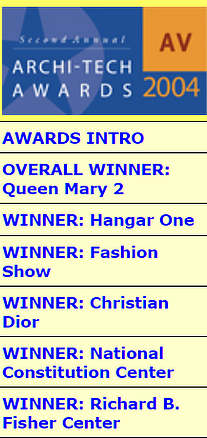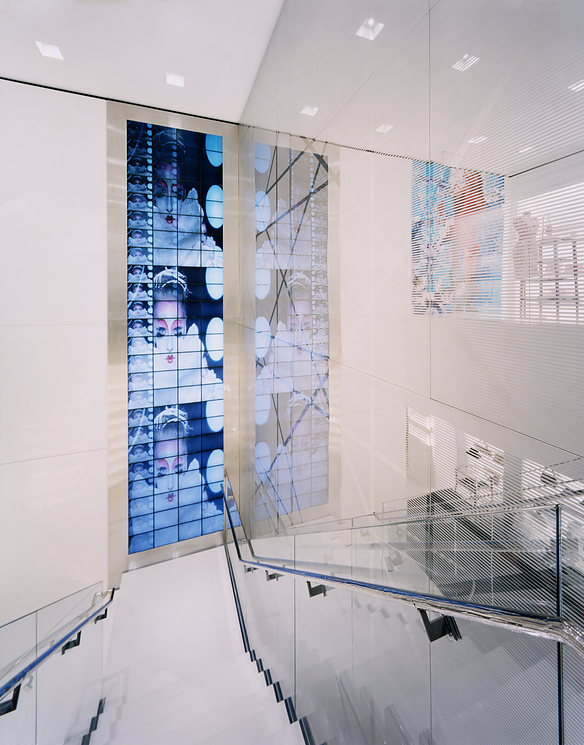Christian Dior
Architecture is fashion, and renowned clothier Christian Dior has proven it with the recent $8 million redesign of their flagship Manhattan location. Centerpiece of the midtown store is a dramatic, 18-foot-tall LCD screen video tower, plus three other stand-alone 16:9 HD plasma screens displaying sexy fashion-show footage throughout the stark, angular, two-story showroom on 57th Street.
The attention-grabbing tower was able to come together only after conventional thinking was challenged. “One of the critical aspects was that Christian Dior gave us a lot of room to express our own creativity and to bring forth the options that would realize their visions of the final product,” says David Schwartz of Essential Communications, the New York City firm that handled audio/video for the $8 million renovation.
“They said, ‘There’s that wall, and we want to put video on it — a lot of it and big. How do we do that?’ At first they wanted to just use the biggest possible plasma screen we could get, and it kept growing from there because it was never big enough.”
The elegant videowall is the result of a close collaboration among Schwartz and the architects, who included both Christian Dior’s in-house architects and the New York firm of MR Architects. “We recreated a stair that they built in other stores,” explains project architect Colby Wong of MR Architects. “It was hard work but worth it, because it’s much better looking than the previous stair.
“The stair, the monitors, and the videowall are the real jewel of the whole project. They became important in drawing you up to the second floor where there’s a lot of real estate, and without that, I don’t think it would have been as successful as it is.”
“The mandate for advanced A/V technology really came from Dior,” Wong continues. “It’s a big part of the stores now. I think it’s in keeping with a lot of trends in retail. It creates drama and interest, it draws you to the second floor, and you get to see the clothes on the runway. It just adds another dimension to the selling environment.”
Working together, Essential Communications and MR Architecture were able to implement a relatively smooth process for proposing various technology and design solutions. “Fortunately, a lot of growth occurred through creative brainstorming,” notes Schwartz. “It could get a little frustrating because we’d do a proposal, research a product, and then [the client would] say, ‘We don’t want that. What about this?’
“They had a vision, but they didn’t know how to technically create what they wanted.”
Wong helped the design team work out clear, basic goals and develop an audio/video technology-centric plan for executing them. Weekly meetings were held with Christian Dior’s Lori Cheek and Scott James during the planning and construction phases. “It takes listening to what the client wants and translating it into a project that fulfills those needs but also draws the customers in, which eventually is going to translate into sales,” says Wong.
“For us, it’s about making sure that the design is as clear as can be, and also is attractive to the customer.”
The commitment by Schwartz to stay on top of the latest available systems helped lead his clients towards the DzWall system, manufactured by a Korean company, Elport, and distributed in the U.S.by Digiwell. Each 15-inch screen is only 4 inches deep, with all power supplies and processing gear built into the framework of the unit. Essential Communications was able to propose a four-across by twenty-four-high tower (96 screens total) that could be installed in the six-inch-deep wall that faced the staircase.
“The products that exist today didn’t exist five years ago,” Schwartz points out. “That’s primarily why I go to the trade shows like InfoComm, which was how I found the video screen vendors. Trade shows and good vendor relationships are crucial to having what amounts to a toolbox on the shelf, with all these different options.”
To present the concept, Essential Communications conducted a small-scale demo’ of the product in their office. “This is a technology that I don’t think everyone was familiar with,” Wong recalls, and the video wall needed to meet Christian Dior’s standards for a seamless appearance between each panel before being approved.
“No one had ever done it before. No one knew what was needed to make it work.” relates Schwartz. “Luckily, they had given us a demo’ to make for the clients, which was what sold the product.” According to Wong, “We were able to see a section of wall together. It was a good process we went through: it allowed us to visualize how it would work and any problems we might encounter, not only with the hardware but the software.”
Inside the manager’s office, a central rack location directs the video to each of the individually addressable monitors in the video tower. Content of runway show footage plays out on DVD to a wideband matrix switcher and digital display scaler in 15-minute repeating loops. The system provides the ability to program up to ten simultaneous images over the 96 screens, including timed effects like chases.
The video tower creates the appearance of multiple inputs and constant motion. While not specifically synch’ed to the video, beat-happy dance music from the store’s sound system completes the illusion of being at an actual fashion show.
“LED screens were considered for the women’s store, but LED is for things like billboards in Times Square,” notes Wong. “LCD was better for the shorter distances, and we had to work with Essential Communications to make sure the joints were as tight as could be. So when you see a woman that’s eight feet tall, you don’t have these big spaces in between.” Although LCD and LED screens are growing in popularity, not every retail store can afford them, Wong adds. “Mostly budget is the barrier, because it is very expensive.”
“I’m very happy with the way it turned out,” he concludes. “It adds another dimension to the retail experience for the customer. I think the overall experience in that store is about seducing the customer. The way it’s all set up, it really draws you in. Dior’s concept was not to make a straight line. Things are offset, you have to meander through, and at the end of the ground floor the LCD screens draw you in and up to the second floor, but not in a straight line.”
Schwartz says the Christian Dior project helps to move retail design forward. “Manufacturers are taking risks and making products that they think will fit into the environment, but contractors like me need to be willing to take risks and put yourself out. Suggesting a video wall from Korea in a product I’d never used before — that I didn’t know they could get done on time!” He admits he was relieved when it worked.
Would he do it again? “A/V technology has become an opportunity for pioneers to excel,” Schwartz reflects. “It’s a chance to go from vanilla to banana split, and the thing I try to do is have fun. The truth of the matter is that many of the people I work with don’t understand A/V, they just know at the end if they’re happy or not, and if their money was spent wisely.
“So I make sure that I interpret their vision the best way I possibly can — and educate them along the way.”
Written by David Weiss
ARCHITECT
MR ARCHITECTURE
SYSTEMS INTEGRATOR
ESSENTIAL COMMUNICATIONS
About us

Follow us on social




